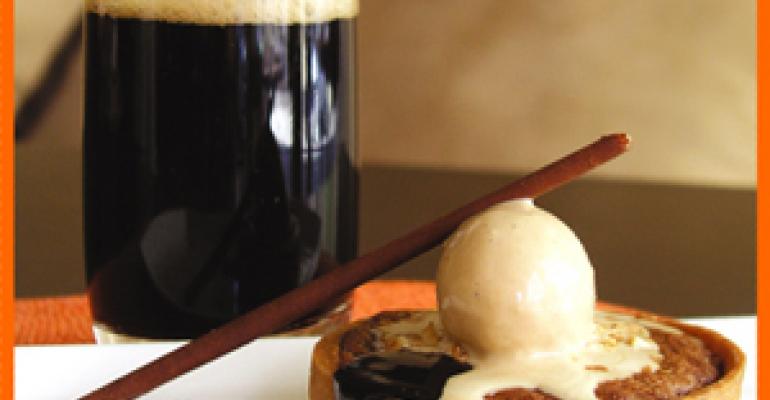At the fine-dining restaurant Sona in Los Angeles three out of the nine courses on the tasting menu are devoted to desserts.
But the best is always saved for last—chocolate.
Chocolate is a vital component of any dessert menu and often is a major driver of dessert sales. And while many restaurateurs will settle for a simple flourless chocolate cake or mousse option to keep chocoholics happy, others use the menu staple as an opportunity for innovation.
Sona’s pastry chef Karen Yoo, for example, has won fans for her chocolate coulant and black-truffle-and-rum-glazed bananas, served with an “heirloom” chocolate ice cream, for $12.
“Coulant” is a derivative of the French word “couler,” which means to flow, an apt description for the cake, which is filled with a warm chocolate ganache that oozes out. Yoo uses a frozen ganache, which is inserted into the cake batter before baking and later melts. The cake is made with almond meal.
The bananas for the dish are cooked in a brown-butter sauce deglazed with rum. To add the truffle flavor, Yoo presses scraps from truffle shavings through a sieve into olive oil with salt. The truffle bits in oil are tossed into the brown-butter sauce to lend their earthy flavor, which Yoo says works nicely with the “sweet fattiness” of the banana. The dessert is plated with cardamom-caramel sauce.
The menu at Sona changes regularly, however, so Yoo’s more recent chocolate addition to the dessert menu is a beignet filled with gianduja ganache that sells for $12.
For the gianduja—hazelnut-flavored chocolate—Yoo uses the same frozen ganache technique, surrounding it with beignet batter before frying to order. The beignet is plated with a brown-butter sauce with candied kumquats and rosemary ice cream.
Nearby at the fine-dining restaurant Providence in Los Angeles, pastry chef Adrian Vasquez also recently finished an all-dessert tasting menu with a chocolate flourish.
His experimental style for the tasting menu led to white-chocolate orbs that exploded with blood-orange juice; basil seeds soaked in liquid until they resemble frogs’ eggs swimming in coconut-scented soy milk; and frozen mashed, molded banana filled with caramel.
The final dish, however, was a dense molded chocolate cream draped with a thin rectangular strip of basil-dusted marshmallow and accented with a puddle of eggless blood-orange curd.
Still, Vasquez notes, “I feel it’s a bit of a cop-out to put a chocolate dessert on a tasting menu.” He says that is because he is originally from Chicago, and the move to Los Angeles, where top-quality fresh produce is at his knife tip almost year-round, sent him into fruit-dessert heaven.
However, he acknowledges the fact that, no matter where a restaurant is located, Americans love their chocolate.
“Do I have to have a chocolate dessert on the menu? Yes, I need to have one, and yes, I struggle with that sometimes.”
Kenny Magana, director of pastry for Wolfgang Puck’s five restaurants in Las Vegas, agrees that chocolate must be on the menu.
“Put ‘chocolate’ in front of anything listed on the menu and it’ll sell,” he says. “Chocolate is our No. 1 seller, as far as desserts go, followed maybe by apple.”
At Spago Las Vegas, for example, a 15-layer chocolate-mocha cake, priced at $12, was added to the dessert menu in mid-February.
Magana uses thin layers of flourless chocolate cake, made with a dark cocoa powder. The cake layers are alternated with thin layers of espresso mousse and chocolate mousse—both made with a semi-sweet chocolate. Candied hazelnuts sprinkled between layers also help to give the cake texture.
“On the menu it reads ‘15 layer cake,’ so the first thing people do when you serve the cake is count,” Magana says.
Typically, Magana tries to have two chocolate dessert options on any restaurant menu.
“You want something warm or hot, and something cool or lighter. You want to have balance,” he says.
In New York, Eric Estrella, pastry chef at InTent, a new venue by pastry master François Payard, also goes for balance, but chocolate is a dominant player on the dessert menu. That’s no surprise, given Payard is known for his high-end chocolates sold through his patisserie and bistro in New York, as well as shops in Brazil and, soon, Las Vegas.
At InTent, a 62-seat restaurant and bar that opened in July 2006, Estrella offers a devil’s food cake served with a chocolate coriander pot de crème. Caramelized bits of Rice Krispies offer a surprise crunch in the crème, as do the addition of almonds and a touch of coffee granité. Plated with unsweetened whipped cream to cut the sweetness, the dessert is $9.50.
A signature dish, however, is Estrella’s relatively simple warm dark-chocolate tart with a molten center, candied hazelnuts and gianduja ice cream.
Tapping into the universal love for chocolate is also the goal of Jeanette and Pierrick Dubreil, who two months ago opened Sweet O Wine & Chocolate Lounge in Glendale, Ariz. Located in a high-end movie theater complex, the restaurant offers a full menu and wine list. But the desserts often steal the show.
One popular choice is the chocolate fondue. Guests have the option of choosing white, milk, dark or milk/caramel chocolate into which they can dip fruit, cookies, nuts, or house-made marshmallows. At $14, the dessert is designed for two.
A top seller, however, is a dessert called The Bomb, priced at $6.50. The chocolate-domed chocolate-mousse cake is filled with a crème brûlée over a hazel-nut sponge cake base. At the center is a kirschmarinated cherry.
A more recent addition, also priced at $6.50, is a dessert called the Dulce. A pecan brownie is layered with honey ganache and topped with a dulce de leche mousse. Milk chocolate and white chocolate “pearls” garnish the dish.
“We pair it with a red wine,” Jeanette Dubreil says. “Chocolate and red wine go perfectly together.”




